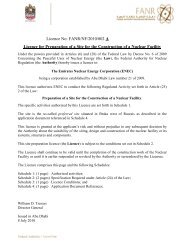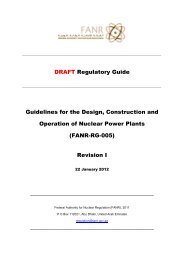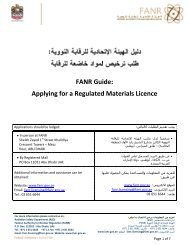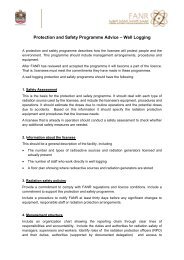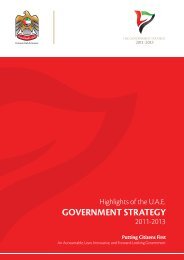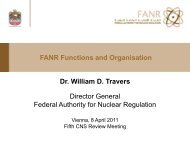Safety Evaluation Report of Barakah Units 1 and
Safety Evaluation Report of Barakah Units 1 and
Safety Evaluation Report of Barakah Units 1 and
Create successful ePaper yourself
Turn your PDF publications into a flip-book with our unique Google optimized e-Paper software.
17<br />
SER Summary-CLA <strong>Barakah</strong> <strong>Units</strong> 1&2<br />
Fuel H<strong>and</strong>ling <strong>and</strong> Storage Systems<br />
H<strong>and</strong>ling systems <strong>and</strong> storage facilities for nuclear fuel are provided in each unit Auxiliary<br />
Building. The new fuel storage pit is designed to hold new fuel assemblies in a dry<br />
condition. Storage racks hold the new fuel in place <strong>and</strong> ensure a safe configuration.<br />
A water-filled pool constructed <strong>of</strong> concrete with interior stainless steel walls provides for the<br />
storage <strong>of</strong> spent fuel assemblies. Stainless steel storage racks are designed to safely hold<br />
up to 20 years <strong>of</strong> spent fuel generation plus space for a full core <strong>of</strong>fload <strong>and</strong> a fresh batch <strong>of</strong><br />
fuel. A fuel transfer canal connects the spent fuel pool to the Containment Building for<br />
refuelling operations.<br />
A fuel transfer system is used to move fuel assemblies between the Auxiliary Building <strong>and</strong><br />
containment via the fuel transfer canal. A refuelling machine is used to insert <strong>and</strong> remove<br />
fuel assemblies from the reactor, while a similar spent fuel h<strong>and</strong>ling machine is used to<br />
move fuel assemblies within the spent fuel pool. A fuel elevator is used to lower new fuel<br />
from the refuel floor into the spent fuel pool.<br />
Plant Cooling Water Systems<br />
Plant water systems include: the essential service water (ESW) system, the component<br />
cooling water (CCW) system, the ultimate heat sink (UHS), the condensate storage <strong>and</strong><br />
transfer system, the turbine generator building closed cooling water system, the chilled water<br />
(CW) system, <strong>and</strong> the makeup demineralizer system.<br />
The ESW system utilizes water from the Arabian Gulf (the plant UHS) to remove heat from<br />
plant SSCs. The ESW system consists <strong>of</strong> two safety-related divisions <strong>of</strong> two pumps <strong>and</strong><br />
three CCW heat exchangers capable <strong>of</strong> removal <strong>of</strong> 100 percent <strong>of</strong> the station safety-related<br />
heat load. The four ESW pumps are provided with upstream traveling screens for debris<br />
removal.<br />
Other Auxiliary Systems<br />
Plant process auxiliaries include a compressed air system for instrumentation <strong>and</strong><br />
equipment applications, systems for sampling liquids <strong>and</strong> gases, equipment <strong>and</strong> floor<br />
drainage system, <strong>and</strong> chemical <strong>and</strong> volume control system (CVCS).<br />
The CVCS maintains the chemistry <strong>and</strong> volume <strong>of</strong> reactor coolant system water, <strong>and</strong> is used<br />
to adjust reactor coolant boron concentration for reactivity control.<br />
Heating, ventilation, <strong>and</strong> air conditioning (HVAC) systems are provided for personnel comfort<br />
<strong>and</strong> safety <strong>and</strong> for equipment protection. The control room, fuel h<strong>and</strong>ling area, <strong>and</strong><br />
emergency diesel generator rooms are among the areas whose HVAC systems are<br />
designed as safety-related systems.<br />
A plant fire protection system consisting <strong>of</strong> fire detection <strong>and</strong> alarm systems, fixed automatic<br />
sprinklers, fire barriers, <strong>and</strong> stationed manual firefighting equipment is provided. Automatic<br />
carbon dioxide systems are installed in the diesel generator <strong>and</strong> fuel tank rooms, <strong>and</strong> in the<br />
cable spreading rooms.<br />
Radioactive Waste Management System<br />
Radioactive waste is managed through the liquid, gaseous, <strong>and</strong> solid waste management<br />
systems housed in the Compound Building. The liquid waste management system,<br />
consisting <strong>of</strong> storage tanks, filters, <strong>and</strong> pumps, is common to both reactor units. Liquid<br />
waste is collected in segregated waste collection tanks, processed to reduce activity level,



